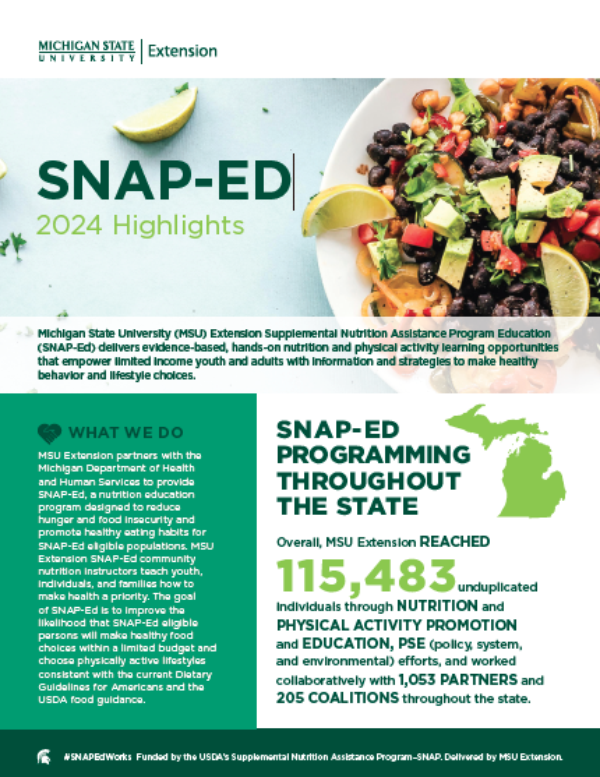
2024 SNAP-Ed Highlights
DOWNLOADMay 15, 2025 - MSU Extension
SNAP-Ed Programming Throughout the State
Overall, MSU Extension reached 115,483 unduplicated individuals through nutrition and physical activity and education, PSE (policy, system, and environmental) efforts, and worked collaboratively with 1,053 partners and 205 coalitions throughout the state.
What We Do
MSU Extension partners with the Michigan Department of Health and Human Services to provide SNAP-Ed, a nutrition education program designed to reduce hunger and food insecurity and promote healthy eating habits for SNAP-Ed eligible populations. MSU Extension SNAP-Ed community nutrition instructors teach youth, individuals and families how to make health a priority. The goal of SNAP-Ed is to improve the likelihood that SNAP-Ed eligible persons will make healthy food choices within a limited budget and choose physically active lifestyles consistent with the current Dietary Guidelines for Americans and the USDA food guidance.
Policy, Systems, and Environmental (PSE) Change
- 363 Community sites reached.
- 72,303 Children and adults reached
PSE Success Story
Through extensive coaching with SNAP-Ed staff and a partnership with the Father Fred Food Pantry, seven daycare sites distributed healthy food boxes that included picture-based recipes to help upwards of 150 young families with food insecurity throughout the Grand Traverse region.
Direct Education
- 8,975 Direct education sessions offered.
- 8,840 Face to face.
- 135 Hybrid.
Adult Dietary Improvements
- 22% Consumed less soda per day.
- 40% Ate more fruits per day.
- 39% Ate more vegetables per day.
Adult Physical Activity Improvements
- 43% increased moderate physical activity participation.
- 40% increased strength training activities.
Youth Health and Nutrition Impact (3rd-12th Grade)
- 29% Increased vegetable consumption.
- 40% Decreased soda consumption.
- 32% Increased physical activity.
- 30% Decreased screen time.
Youth Health and Nutrition Impact (K-2nd Grade)
- 92% Washed their hands more before handling food.
- 63% Gring more fruits and veggies as snacks.
- 99% Can identify healthy food choices.
- 85% Increased physical activity.
- 92% Are now eating more fruits and vegetables.
Social Marketing
Healthy Drinks, Healthy Kids
MSU Extension, in partnership with the Sugar Smart Coalition and shared by the Association of Child Development, has developed messaging and graphics in support of the Healthy Drinks, Healthy Kids social marketing campaign that promotes the reduction of sugar sweetened beverages.
- 13,325 Total reach for all content (total count, duplicative).
- 11,660 The number of users that saw any of our posts at least once (unduplicated).
- 793 The number of clicks on any of the content, including reactions, likes, comments, and shares (total count, duplicative).
Move your Way®
In FY24, MSU Extension partnered with the Office of Disease Prevention and Health Promotion (ODPHP) to promote the Move Your Way® campaign as a social marketing effort to encourage physical activity participation among SNAP-Ed eligible adults.
- 7-Month campaign (March-September 2024).
- 935,676 Estimated eligible adult population across 28 targeted counties.
- 19,771,278 Total impressions.
- 4,717% Increase in views on MSU Extension physical activity website.
Indirect Education
Indirect education activities are complementary approaches to direct education and PSE coaching and include informative channels like: articles, fact sheets, radio podcasts, social media postings, web presence, and educational videos.
- 1,017,341 Adults and youth reached.
Social Media
- 2,560 Instagram impressions.
- 339 Video hours watched on YouTube
- 186,821 Facebook impressions.
- 178 MI Health Matters educational videos now available.
SNAP-Ed Success Stories
Houghton County
After working with a SNAP-Ed coach, Barkell Elementary School started incorporating a Healthy Eating or Living Tip of the Week into their daily announcements.
Marquette County
In partnership with the Upper Peninsula Food As Medicine project, a SNAP-Ed participant completed all 10 My Way to Wellness online lessons, participated in all 10 discussions, posted that she learned new ways to cook and how to make healthy choices and for her participation in the program, she earned $40 in vouchers to purchase fruits & veggies at her local farmers market.
Ostego County
A SNAP-Ed Instructor worked with the Program Director at Patriot Place to design and improve the eight shared kitchens that the male veterans experiencing homelessness were using. The veterans were able to access the improved kitchens and use skills learned in their nutrition classes to prepare more meals from scratch, using whole foods, lean meats, and fresh produce.
Kent County
A participant of a Cooking for One class shared that after attending the program she drank more water, walked more, and replaced salt with a spice blend learned in class. This resulted in her blood pressure and sugar levels improving to the point that her doctor check-ins were reduced to twice a year.
Lapeer County
A SNAP-Ed Instructor provided coaching and education for Silver Maple Village in Lapeer that resulted in 200, three-pound bags of produce being delivered each week to residents of the senior complex and low income apartments.
Clinton County
A SNAP-Ed Instructor worked with the Service Coordinator for Suntree Apartments to establish a connection with the Good News Soup Kitchen. This resulted in food boxes being delivered to the senior residents that were facing food insecurity and transportation barriers to food access.
Calhoun County
A Title 1 Parapro, that observed a nutrition program at Tekonsha Elementary, decided to make nutrition books available in the school’s library to support ongoing learning after the program.



 Print
Print Email
Email




